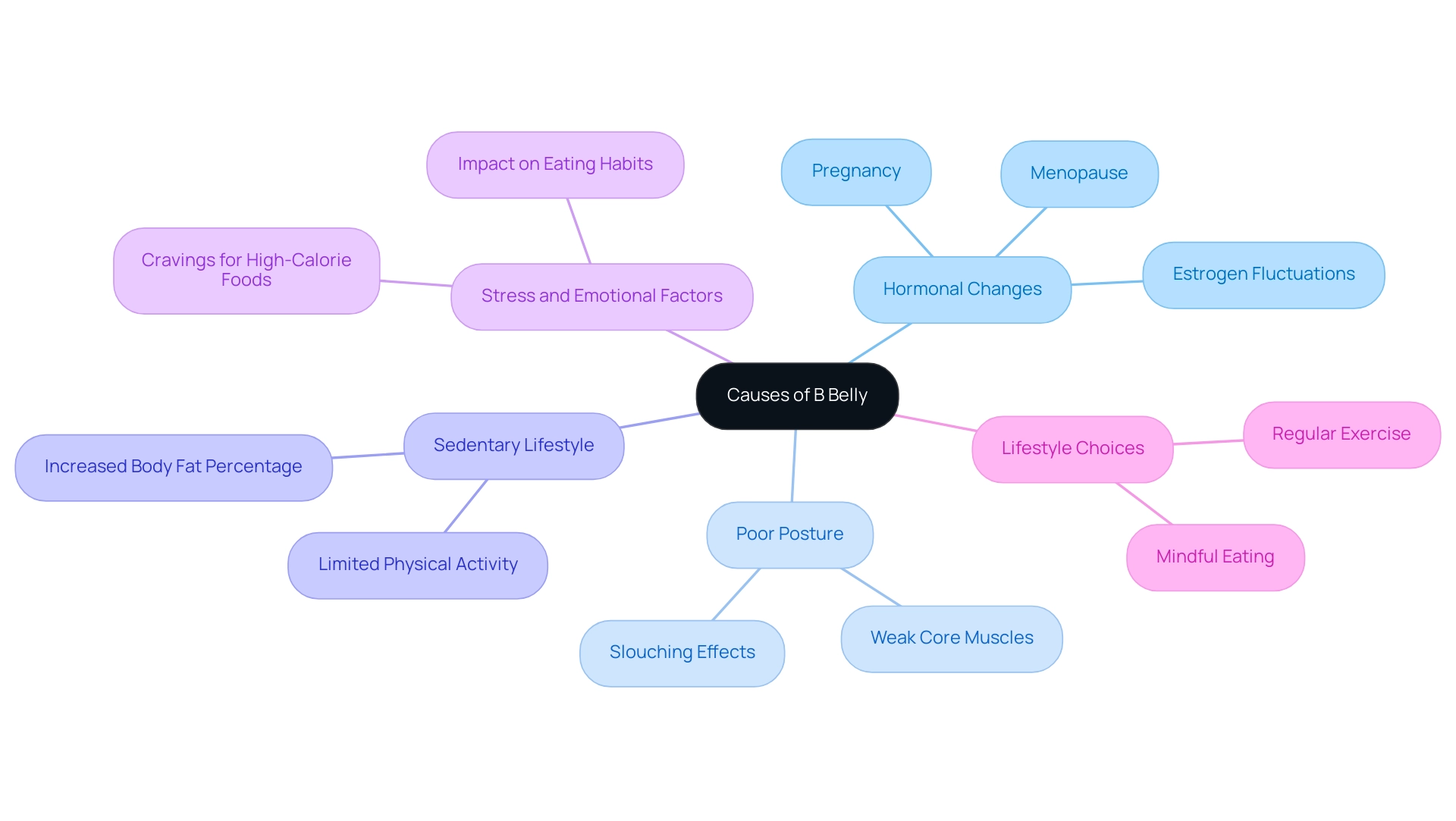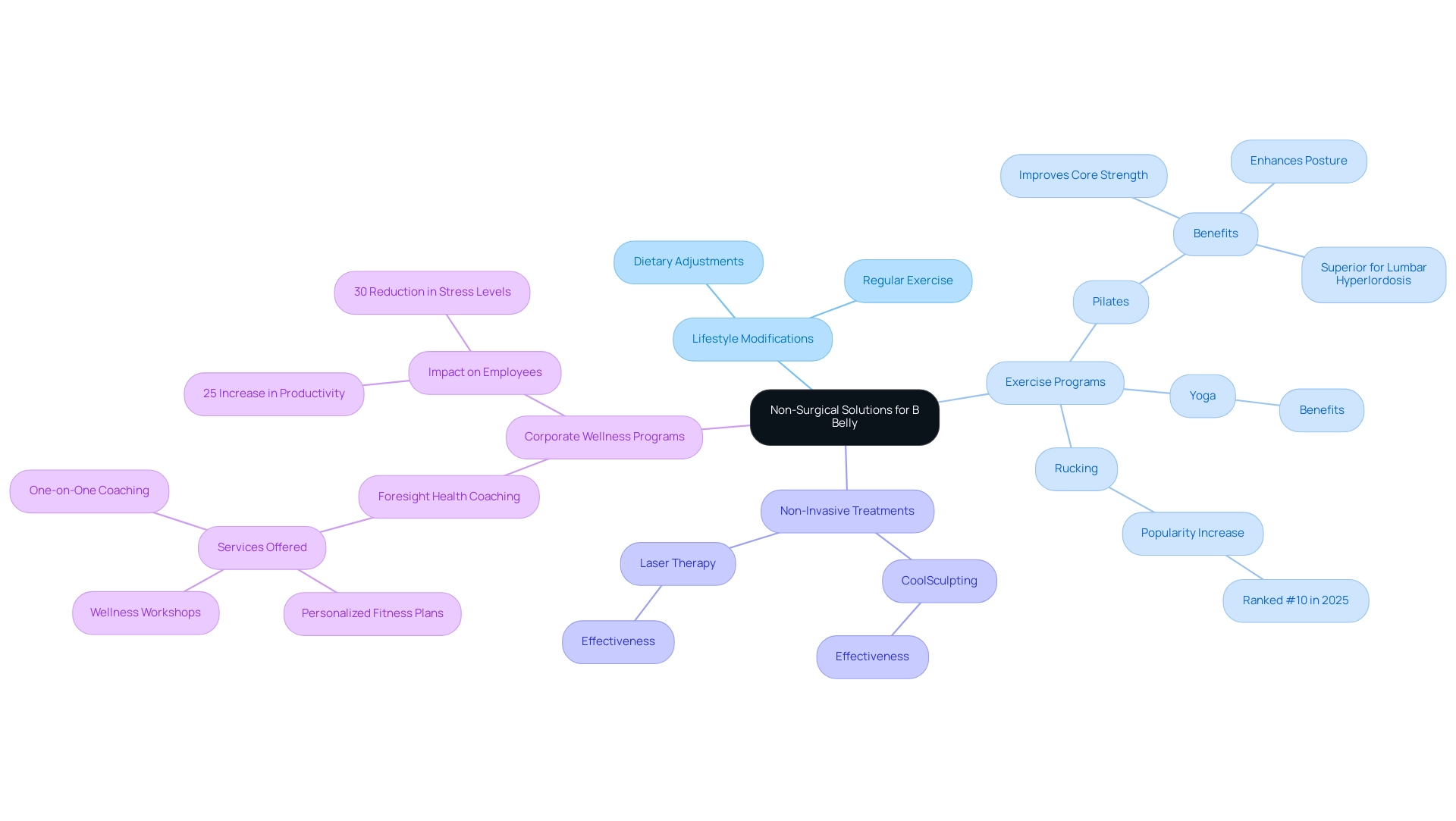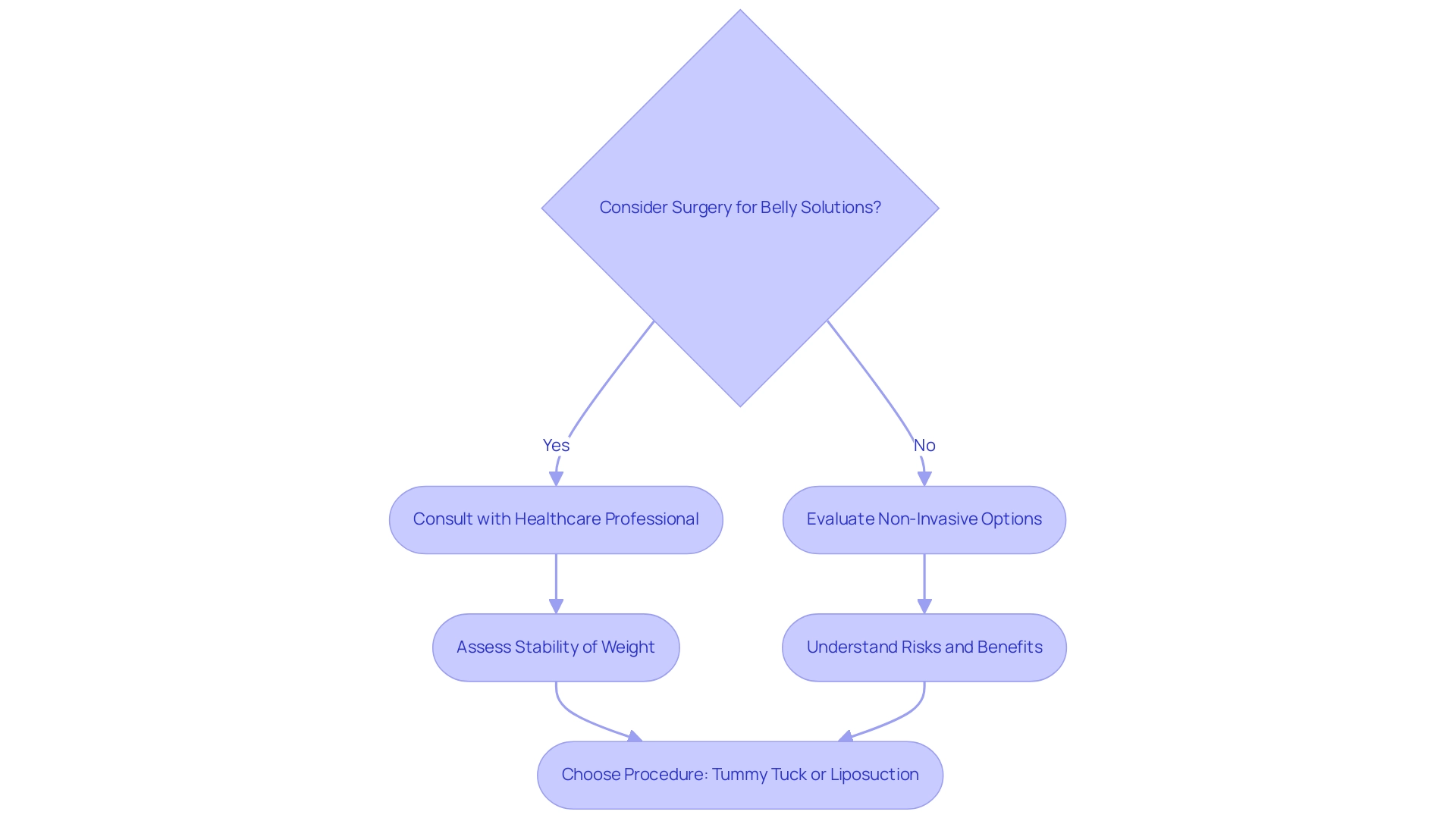Overview
The article examines various options for achieving a flatter stomach, particularly focusing on the B belly condition and its underlying causes, which encompass hormonal changes, poor posture, and lifestyle factors. It underscores a holistic approach that integrates:
- Lifestyle modifications
- Non-surgical treatments such as Pilates and CoolSculpting
- Surgical options, when necessary
Furthermore, it addresses the emotional impacts of body image, fostering a healthier self-acceptance and overall well-being.
Introduction
In a world where body image is under constant scrutiny, the phenomenon of B Belly has emerged as a significant concern for many individuals. This distinctive abdominal shape, characterized by a crease resembling the letter 'B', can arise from various factors, including:
- Genetics
- Hormonal changes
- Lifestyle choices
Understanding the nuances of B Belly is essential—not only for those who may feel self-conscious about their appearance but also for fostering a healthier relationship with one’s body. As societal standards of beauty evolve, the conversation surrounding body image has shifted towards acceptance and self-love, encouraging individuals to embrace their unique shapes while navigating the complexities of health and fitness.
Furthermore, by exploring the causes, emotional impacts, and both surgical and non-surgical solutions for B Belly, this article aims to provide valuable insights and support for those on their journey to improved self-esteem and well-being.
Understanding B Belly: What It Is and Why It Matters
B shape' refers to a specific abdominal contour characterized by a crease or fold that resembles the letter 'B.' This shape can arise from various factors, including genetics, physical composition, and lifestyle choices. Understanding the B shape is crucial for individuals who may feel self-conscious about their appearance, as it significantly influences perceptions of beauty and self-worth.
Research indicates that appearance perception is pivotal to self-worth, particularly in 2025, where societal norms and media portrayals continually shape beauty standards. Those seeking solutions for a B belly may experience feelings of inadequacy or dissatisfaction, potentially affecting their overall well-being. It is essential to recognize that this shape is common and influenced by multiple factors, enabling individuals to pursue their health and fitness goals with a more informed and compassionate perspective.
Statistics show that a considerable portion of the population struggles with body image issues, with many women voicing concerns about their abdominal appearance. Notably, 6.1% of children and teenagers aged 2 to 19 face severe obesity, underscoring the broader context of body image concerns and obesity trends. The prevalence of body dissatisfaction correlates with various psychological outcomes, including diminished self-esteem and heightened anxiety.
By comprehending the factors contributing to B belly solutions, individuals can more effectively navigate their fitness journeys and cultivate a healthier relationship with their bodies. Real-life examples demonstrate the resilience of individuals overcoming challenges related to B belly solutions, highlighting their commitment to self-improvement. Expert insights emphasize the importance of focusing on overall wellness rather than merely appearance, advocating for a balanced approach to fitness that prioritizes well-being over societal pressures. Furthermore, the decline in stomach cancer rates in the US, attributed to improved food preservation techniques and reduced Helicobacter pylori infections, underscores the importance of overall wellness in discussions about physical appearance.
As we advance through 2025, the conversation surrounding physical appearance continues to evolve, with an increasing emphasis on acceptance and self-love. By addressing the psychological implications of body shape and fostering positive narratives, individuals can create a more supportive environment for themselves and others, ultimately enhancing self-esteem and body confidence. Ahmedin Jemal's recognition of the diligent efforts of cancer registries highlights the necessity for accurate health information, which is vital in shaping public perception and understanding of health-related issues.

Causes of B Belly: Unpacking the Factors Behind the Condition
The formation of a B belly can be addressed through various solutions related to several interrelated factors. Hormonal changes, particularly during pregnancy and menopause, significantly influence fat distribution in the abdominal area. Research suggests that fluctuations in estrogen levels can lead to increased fat accumulation around the belly, highlighting the importance of understanding hormonal impacts on composition.
As Dr. Gail Greendale observes, "a simple measurement of weight does not illustrate what is happening 'under the skin.'" This underscores the necessity of considering composition metrics in discussions about health and weight.
In addition to hormonal influences, poor posture plays a critical role in the appearance of a protruding stomach. Studies have shown that slouching can lead to weakened core muscles, which may contribute to an expanded waistline. Furthermore, a sedentary lifestyle exacerbates this issue; individuals who engage in limited physical activity are more prone to experiencing alterations in form, including the emergence of a protruding abdomen.
A statistical analysis of health metrics revealed that individuals with higher levels of physical activity tend to have lower body fat percentages, reinforcing the importance of exercise in combating abdominal fat.
Stress and emotional factors also contribute to unhealthy eating habits, which can lead to weight gain and the development of abdominal fat. The connection between stress and increased abdominal fat is well-documented, as stress often triggers cravings for high-calorie comfort foods. Notably, employees who exercise for at least 30 minutes three times per week are more likely to report feeling motivated at work, which can positively influence their lifestyle choices.
Comprehending these causes is crucial for those aiming to manage or reduce their abdominal area effectively. Moreover, expert opinions emphasize that addressing lifestyle factors—such as incorporating regular physical activity and improving posture—can lead to significant improvements in abdominal shape. Real-world examples further illustrate these points; individuals who have adopted healthier lifestyles, including consistent exercise and mindful eating, report noticeable reductions in their B belly solutions.
Foresight Health Coaching's comprehensive health coaching services provide customized programs for both individuals and corporations, addressing these factors through personalized fitness coaching, nutritional guidance, and wellness workshops. Their corporate memberships include in-person wellness talks, comprehensive pantry and nutrition services, and access to their exclusive wellness app, which enhances the overall experience by providing features such as daily workouts, guided nutrition plans, mindset strategies, and community support. The unique backgrounds of the founders, Paul and Chris, who bring over 2.5 years of high-performance coaching experience, contribute to a holistic approach that combines in-person and digital interactions for maximum accessibility.
By recognizing and addressing these contributing factors, individuals can take proactive steps toward achieving a flatter stomach while benefiting from the holistic approach provided by Foresight Health Coaching.

Non-Surgical Solutions for B Belly: Exploring Effective Treatments
Non-surgical solutions for addressing B belly can be categorized as b belly solutions, encompassing a combination of lifestyle modifications, including regular exercise and dietary adjustments. Engaging in physical activities that specifically target core strength, such as Pilates and yoga, effectively tones abdominal muscles and enhances posture. Pilates, in particular, focuses on controlled movements and mindful breathing, strengthening the entire core musculature, making it a valuable practice for those looking to reduce B Belly.
In 2025, Pilates gained recognition for its effectiveness in improving core strength, with studies indicating that participants experience significant improvements in muscle tone and posture. A notable case study demonstrated that Pilates was superior in treating lumbar hyperlordosis compared to other exercise methods, highlighting its potential benefits for overall core stability. In Alexandru's study, the degree of spinal curvature and the level of change from lordosis improved in all 11 subjects, further supporting the effectiveness of Pilates in addressing core strength and related b belly solutions.
Additionally, rucking has risen in popularity, moving from #13 in 2024 to #10 in 2025, indicating a growing trend in physical activities that can complement core strengthening exercises. Furthermore, organizations can leverage partnerships with Foresight Health Coaching, which offers tailored corporate wellness programs designed to enhance employee health, productivity, and cognitive performance through individualized support. Specific services include personalized fitness plans, wellness workshops, and one-on-one coaching sessions that cater to the unique needs of employees.
Non-invasive treatments such as CoolSculpting and laser therapy have increased in popularity due to their effectiveness in reducing localized fat deposits, with CoolSculpting demonstrating promising success rates in 2025, offering people a viable option for attaining a flatter stomach without the necessity for surgical intervention.
These non-surgical alternatives, including b belly solutions, combined with regular exercise and dietary adjustments, promote a healthier lifestyle among employees while improving their chances of reaching their desired physique. For instance, a recent case study involving a corporate client revealed that employees who participated in Foresight's wellness programs reported a 25% increase in overall productivity and a 30% reduction in stress levels. By integrating such wellness programs, companies can cultivate a more cohesive team culture that promotes overall well-being and productivity.

Surgical Interventions for B Belly: When Is Surgery the Right Choice?
Surgical procedures, including abdominoplasty (tummy tuck) and liposuction, present feasible alternatives for individuals striving to achieve their desired body shape through non-surgical methods. These procedures are particularly effective in eliminating excess skin and fat, resulting in a more contoured appearance. However, it is essential to approach surgery as a last resort, typically recommended for those who have attained a stable weight and possess realistic expectations regarding the outcomes.
When contemplating surgical options for belly solutions, consulting with a qualified healthcare professional is crucial. This expert can provide personalized guidance based on specific circumstances. For instance, studies indicate that abdominoplasty boasts a success rate of approximately 86% in achieving patient satisfaction, underscoring its effectiveness for those seeking significant contouring. Furthermore, the importance of regular exercise cannot be overstated; employees who engage in physical activity for at least 30 minutes three times per week are more likely to report feeling motivated at work, a vital factor in maintaining a healthy lifestyle.
Moreover, the decision to undergo surgery should be informed by a comprehensive understanding of the risks and benefits associated with each procedure. While liposuction effectively targets localized fat deposits, it may not address issues related to skin elasticity, wherein a tummy tuck may prove more beneficial. Expert opinions suggest that individuals should consider surgical options when non-invasive methods have failed, and they are motivated to achieve a flatter stomach.
This perspective aligns with the philosophy of Foresight Health Coaching, which emphasizes the importance of tailored wellness programs that can enhance employee well-being and productivity.
As we look ahead to 2025, the landscape of body contouring continues to evolve, with advancements in surgical techniques leading to improved recovery statistics. Recent data reveals that patients undergoing liposuction experience a recovery time of approximately one to two weeks, enabling them to return to normal activities relatively quickly. This marks a significant improvement compared to previous years, rendering surgical options more appealing for those seeking effective belly solutions.
Ultimately, the choice between tummy tuck and liposuction should be guided by personal goals and the counsel of healthcare professionals. As Regan JP noted, "The earlier signs and symptoms of a complication are identified, the better the prognosis and outcome," reinforcing the importance of consulting healthcare professionals before considering surgical options. As the field of body contouring advances, staying informed about the latest developments and success stories empowers individuals to make the best choices for their well-being and aesthetic aspirations.
Moreover, fostering a healthier team environment through corporate wellness programs, as emphasized by Foresight Health Coaching, is crucial in supporting individuals on their wellness journeys.

Lifestyle Changes for a Flatter Stomach: Diet and Exercise Strategies
To effectively manage belly solutions, individuals should prioritize a balanced diet that emphasizes whole foods, including an abundance of fruits, vegetables, lean proteins, and healthy fats. Recent studies indicate that dietary modifications have a crucial impact on fat reduction, emphasizing nutrient-rich foods that yield better wellness outcomes. Notably, the weight loss supplement industry generates $2.1 billion annually, underscoring the widespread concern regarding weight loss and the importance of effective dietary strategies.
Regular physical activity is equally essential; engaging in cardiovascular exercises and strength training not only aids in reducing overall fat but also enhances muscle tone, contributing to a flatter stomach. Data from 2025 reveal that individuals who incorporate exercise into their routines at least three times weekly experience significant enhancements in weight loss and general well-being. Furthermore, successful weight maintenance is often linked to high levels of physical activity, consistent eating patterns, and self-monitoring behaviors, as highlighted in the case study titled "Self-Regulation and Weight Maintenance."
This study illustrates that maintaining weight loss is often more challenging than losing weight, and interventions that enhance self-efficacy, promote self-monitoring, and provide social support can improve the likelihood of sustaining weight loss over the long term.
In addition to diet and exercise, integrating mindfulness practices, such as stress management techniques, can further bolster weight loss efforts. These practices foster a healthier relationship with food and body image, which is crucial for sustainable lifestyle changes. As noted by Lean & Malkova, diet-induced weight loss leads to long-term changes in appetite-related gut hormones, which may favor increased appetite and weight regain.
By embracing these comprehensive approaches, including tailored coaching and assistance through our user-friendly wellness app, individuals can strive for a flatter stomach with belly solutions while enhancing their overall well-being.
Foresight Health Coaching offers tailored programs for both individuals and corporate groups, including in-person wellness talks, nutrition services, and one-on-one coaching sessions designed for high-performing individuals. Our health coaching app features daily programming, personalized workouts, and video demonstrations, ensuring users have all the tools they need at their fingertips. With direct messaging capabilities for personalized support and community engagement for motivation, Foresight Health Coaching empowers clients to make lasting lifestyle changes.

The Emotional Impact of B Belly: Addressing Body Image Concerns
The existence of a B Belly often triggers feelings of self-consciousness and dissatisfaction with physical appearance, which can be alleviated through effective B Belly solutions, significantly affecting emotional well-being. Addressing these emotional concerns is crucial for fostering a positive self-image and promoting acceptance of one's physique. Engaging in supportive communities, whether in-person or online, offers individuals a platform for encouragement and understanding—essential for emotional resilience.
Furthermore, seeking professional help can provide guidance for those struggling with image issues. By addressing the emotional aspects related to B Belly solutions, individuals can cultivate a healthier mindset, leading to improved self-esteem and an overall better quality of life. Feel proud and confident as you navigate through life.
Research indicates that acceptance of oneself profoundly impacts mental health. Individuals who embrace themselves report lower levels of anxiety and depression. As we advance through 2025, the discussion surrounding physical appearance continues to evolve, emphasizing community support and acceptance. Strategies for fostering a positive self-image include:
- Participating in group activities that promote positivity about one's appearance
- Engaging with resources that challenge societal beauty standards
Moreover, integrating physical activity into daily routines can significantly enhance emotional well-being. Studies reveal that employees who exercise for at least 30 minutes three times per week are more likely to feel motivated at work, translating into improved job performance and overall satisfaction. Real-world examples demonstrate the effectiveness of community support in tackling image concerns.
Initiatives encouraging open discussions about physical appearance have been shown to enhance emotional well-being and reduce feelings of isolation. Furthermore, workplace exercise initiatives and wellness coaching sessions have been associated with decreased absenteeism and presenteeism, aligning with the mission of Foresight Wellness Coaching.
Expert insights from professionals highlight the significance of addressing psychological factors connected to physical image. For example, decreasing social media usage can result in short-term beneficial effects on self-image, encouraging individuals to be conscious of their media consumption as part of their journey toward self-acceptance. By prioritizing emotional health and body acceptance, individuals can navigate the challenges posed by B Belly solutions more effectively, leading to a more fulfilling and confident life.

Conclusion
Understanding the complexities surrounding B Belly is vital for fostering a healthier relationship with one's body. This article has delved into the various causes of B Belly, emphasizing the roles of genetics, hormonal changes, and lifestyle factors, including stress and posture. Recognizing that many individuals share this experience can help alleviate feelings of inadequacy and promote self-acceptance.
Furthermore, the exploration of both non-surgical and surgical solutions highlights the importance of tailored approaches to managing B Belly. From engaging in targeted exercises like Pilates and rucking to considering advanced treatments such as CoolSculpting, individuals have multiple avenues to explore on their journey to improved body confidence. The insights provided underscore that a balanced combination of diet, exercise, and, when necessary, medical intervention can lead to meaningful changes.
The emotional impact of B Belly cannot be overlooked. By fostering supportive communities and engaging in body-positive practices, individuals can cultivate resilience and enhance their self-esteem. The evolving conversation around body image encourages acceptance and self-love, reinforcing the idea that health and well-being transcend traditional beauty standards.
Ultimately, embracing one's unique body shape while taking proactive steps toward health can lead to a more fulfilling life. By prioritizing emotional well-being, adopting healthy lifestyle changes, and seeking appropriate support, individuals can navigate their paths toward confidence and self-acceptance, transforming their relationship with their bodies for the better.




